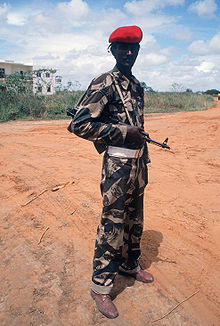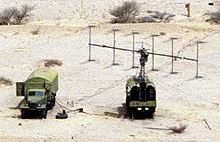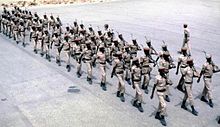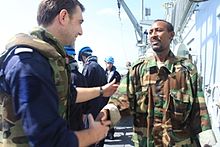- Military of Somalia
-
Military of Somalia 
Founded 1960 Service branches Somali National Army (Army)
Somali Navy (Navy)
Somali Air Corps (Air Force)
Somali Police Force (Police Force)Headquarters Mogadishu, Somalia Leadership Commander-in-Chief General Abdikarim Yusuf Adam Minister of Defense Hussein Arab Isse Manpower Military age 16 Available for
military service2,261,704 (2010 est.; males)
2,217,584 (2010 est.; females), age 6–49Fit for
military service1,328,567 (2010 est.; males)
1,386,971 (2010 est.; females), age 6–49Reaching military
age annually99,919 (2010 est.; males)
99,771 (2010 est.; females)Expenditures Percent of GDP 0.9% (2005) Industry Foreign suppliers European Union, United States, Gulf States The Military of Somalia was, up until 1991, made up of the army, navy, air force, and air defense command. The outbreak of the Somali Civil War during that year led to the de facto dissolution of the national armed forces. However, efforts to re-establish a regular armed force by a re-constituted Somali federal government have made progress so far. The military of Somalia is now overseen by the TFG Ministry of Defense, a branch of Somalia's new Transitional Federal Government (TFG) that was formed in 2004. The Somaliland and Puntland regional governments maintain their own security and police forces.
Contents
History
Historically, Somali society accorded prestige to the warrior (waranle) and rewarded military prowess. Except for a man of religion (wadaad), and they were few in number, all Somali males were considered potential warriors.
Somalia's many Sultanates each maintained regular troops. In the early Middle Ages, the conquest of Shewa by the Ifat Sultanate ignited a rivalry for supremacy with the Solomonic Dynasty.
Many similar battles were fought between the succeeding Sultanate of Adal and the Solomonids, with both sides achieving victory and suffering defeat. During the protracted Ethiopian-Adal War (1529-1559), Imam Ahmad ibn Ibrihim al-Ghazi defeated several Ethiopian Emperors and embarked on a conquest referred to as the Futuh Al-Habash ("Conquest of Abyssinia"), which brought three-quarters of Christian Abyssinia under the power of the Muslim Adal Sultanate.[1][2] Al-Ghazi's forces and their Ottoman allies came close to extinguishing the ancient Ethiopian kingdom, but the Abyssinians managed to secure the assistance of Cristóvão da Gama's Portuguese troops and maintain their domain's autonomy. However, both polities in the process exhausted their resources and manpower, which resulted in the contraction of both regional powers and changed regional dynamics for centuries to come. Many historians trace the origins of hostility between Somalia and Ethiopia to this war.[3] Some scholars also argue that this conflict proved, through their use on both sides, the value of firearms such as the matchlock musket, cannons and the arquebus over traditional weapons.[4]
At the turn of the 20th century, the Majeerteen Sultanate, Sultanate of Hobyo, Warsangali Sultanate and Dervish State employed cavalry in their battles against the imperialist European powers during the Campaign of the Sultanates.
In Italian Somaliland, eight "Arab-Somali" infantry battalions and several irregular units of Italian officered dubats were established. These units served as frontier guards and police. There were also Somali artillery and zaptié (carabinieri) units forming part of the Italian Royal Corps of Colonial Troops from 1889 to 1941.
In 1914, the Somaliland Camel Corps was formed in the British Somaliland protectorate and saw service before, during, and after the Italian invasion of the territory during World War II.
 Major General Salaad Gabeyre Kediye, an early Somali military leader and the "Father of the Revolution" that succeeded Somalia's civilian administration.
Major General Salaad Gabeyre Kediye, an early Somali military leader and the "Father of the Revolution" that succeeded Somalia's civilian administration.
At independence in 1960, Somalia possessed a small and lightly equipped army with officers trained in Britain, Egypt and Italy. After a military coup d'état in 1961, this force was expanded and modernized with the assistance of Russian and Cuban advisors.
The Somali National Army (SNA) was battle-tested in 1964 when the conflict with Ethiopia over the Somali-inhabited Ogaden erupted into warfare. On 16 June 1963, Somali guerrillas started an insurgency at Hodayo, in eastern Ethiopia, a watering place north of Werder, after Ethiopian Emperor Haile Selassie rejected their demand for self-government in the Ogaden. The Somali government initially refused to support the guerrilla forces, which eventually numbered about 3,000. However, in January 1964, after Ethiopia sent reinforcements to the Ogaden, Somali forces launched ground and air attacks across the border and started providing assistance to the guerrillas. The Ethiopian Air Force responded with punitive strikes across its southwestern frontier against Feerfeer, northeast of Beledweyne and Galkacyo. On 6 March 1964, Somalia and Ethiopia agreed to a cease-fire. At the end of the month, the two sides signed an accord in Khartoum, Sudan, agreeing to withdraw their troops from the border, cease hostile propaganda, and start peace negotiations. Somalia also terminated its support of the guerrillas.
During the power vacuum that followed the assassination of Somalia's second president, Abdirashid Ali Shermarke, the military staged a coup d'état on October 21, 1969 (the day after Shermarke's funeral) and took over office. Major General Mohamed Siad Barre, who then commanded the army, was installed as President of the Supreme Revolutionary Council (SRC), the new government of Somalia.[5] The country was renamed the Somali Democratic Republic, and Barre became the spokesman and leader of the new revolutionary government. In 1971, he announced the regime's intention to phase out military rule.
 Somali president Abdullahi Yusuf Ahmed, a decorated war hero that participated in the 1964 border conflict and later led the Somali National Army's (SNA) southern front in the Ogaden War.
Somali president Abdullahi Yusuf Ahmed, a decorated war hero that participated in the 1964 border conflict and later led the Somali National Army's (SNA) southern front in the Ogaden War.
In July 1977, the Ogaden War broke out after Barre's government sought to incorporate the predominantly Somali-inhabited Ogaden region into a Pan-Somali Greater Somalia. The Somali national army invaded the Ogaden and was successful at first, capturing most of the territory. The invasion reached an abrupt end with the Soviet Union's sudden shift of support to Ethiopia, followed by almost the entire communist world siding with the latter. The Soviets halted their previous supplies to Barre's regime and increased the distribution of aid, weapons, and training to Ethiopia's newly-communist Derg regime. They also brought in around 15,000 Cuban troops to assist the Ethiopian military. By 1978, the Somali troops were ultimately pushed out of the Ogaden.
This shift in support by the Soviet Union motivated the Barre government to seek allies elsewhere. It eventually settled on Russia's Cold War arch-rival, the United States, which had been courting the Somali government for some time. All in all, Somalia's initial friendship with the Soviet Union and later partnership with the United States enabled it to build the largest army in Africa.[6]
This increase in military strength coincided with a consolidated effort by various clan-based rebel groups in the country — most notably the Somali Salvation Democratic Front led by Abdullahi Yusuf Ahmed, a decorated war hero and former colonel in the army, the Isaaq-led Somali National Movement (SNM), and General Mohamed Farah Aidid's United Somali Congress — to destabilize the Barre regime, eventually succeeding in ousting it altogether in the ensuing Somali Civil War that broke out in 1991. The Military of Somalia subsequently disbanded, and various local warlords began competing for influence in the power vacuum that followed.
However, in 2004, a new Somali government was formed. This Transitional Federal Government (TFG) led by Abdullahi Yusuf Ahmed, who had since been elected President of Somalia, would include among its mandates the re-establishment of Somalia's Armed Forces. An agreement between the TFG and the Islamic Courts Union (ICU) to build a national military was reached "in principle" on September 5, 2006, but in practice, political disagreements scuttled talks scheduled for October 30 in Khartoum, Sudan.[7][8] After the defeat of the ICU in December 2006–January 2007, another agreement was reached between the warlords and the government for the disarmament of the militias, and for former militia members to apply to join the army.
By 2009, a rebuilding Somalia had re-established its national army and police force, with a new navy and air force also in the process of being re-constituted.
Somali National Army (SNA)
History
 A Somali soldier poses for a photograph during the multinational joint service exercise BRIGHT STAR '85.
A Somali soldier poses for a photograph during the multinational joint service exercise BRIGHT STAR '85.
Organization
The army was organized into 12 divisions which controlled all of the following:
- 4 tank brigades,
- 45 mechanized and infantry brigades,
- 4 commando brigades,
- 1 surface-to-air missile brigade,
- 3 artillery brigades, 30 field battalions, and
- an air defense battalion.
Ground Forces equipment
- Cadillac Gage Commando
- AK-47
- M-16
- AK-63
- SAR-80
- Centurion main battle tanks
- M47 Patton main battle tanks
- T-54/T-55 main battle tanks
- T-34 medium tanks
- M41 Walker Bulldog light tanks
- Panhard AML-90 armored cars
- BRDM-2 reconnaissance vehicles
- BTR-50 tracked armored personnel carriers
- BTR-40, BTR-60 and BTR-152 wheeled armored personnel carriers
- Fiat 6614/6616 armored personnel carriers
- BMR-600 wheeled APC
- BGM-71 TOW anti-tank guided missiles
- M198 155 mm towed howitzers
Air Defense Forces equipment
The Air Defense Forces consisted of 7 brigades.
 An aerial view of a Soviet-made Spoon Rest A (P-12) early warning radar unit, part of radar installation operated by Somali troops at the Berbera airport. The photo was taken during Exercise EASTERN WIND '83, the amphibious landing phase of Exercise BRIGHT STAR '83.
An aerial view of a Soviet-made Spoon Rest A (P-12) early warning radar unit, part of radar installation operated by Somali troops at the Berbera airport. The photo was taken during Exercise EASTERN WIND '83, the amphibious landing phase of Exercise BRIGHT STAR '83.
The serviceability of the equipment is poor and status is unknown.
- SA-3 Goa surface-to-air missiles (not operational)
- SA-2 Guideline surface-to-air missiles (not operational)
- Strela 2 portable surface-to-air missiles (operational status unknown)
- P-12
- P-15 Termit - coastal defense surface to surface missiles
- P-30
- P-35
New Army
General
On 20 June 2005, the army chief of staff, General Ismail Qasim Naji, announced his intention to establish a new Somali army. A projected 10,000 soldiers recruited from the northern Puntland region and the central areas of Somalia were to be based in the southern town of Beledweyne, while another 10,000 soldiers from the Juba and Shabelle regions would be based in Jowhar.[9]
Training
The military of Somalia received a major boost in April 2009 when various international donors at a UN-sponsored conference pledged over $250 million to help improve security in the country. Part of the funds are earmarked for an increased armed force of 6,000 members as well as an augmented police force of 10,000 men.[10]
In addition, the Somali military received 40 tonnes worth of arms and ammunition in June 2009 from the US government to assist it in combating the insurgency within southern Somalia.[11] More equipment and training are also expected.[12]
A few months later in November 2009, the European Union announced its intention to train 2 Somali battalions (around 2,000 troops), which will complement other training missions and bring the total number of better-trained Somalian soldiers to 6,000.[13] The 2 battalions are expected to be ready by August 2011.[14] On April 21 2011, 1,000 recruits completed training in Uganda as a part of the agreement with the EU.[15]
In May 2010, Turkey and the Transitional Federal Government of Somalia also signed a military training agreement, in keeping with the provisions outlined in the Djibouti Peace Process.[16]
As part of the EU-funded and led military training program, 900 SNA soldiers graduated from the Bihanga Military Training School in the Ibanda District of Uganda on 31 August.[17][18] 150 personnel from the EU are taking part in the training process, which trains around 2,000 Somalian troops per year.[18]
On 16 September 2011, President Sharif Sheikh Ahmed laid down the foundation for a new military camp for the Somalian National Army (SNA) in the Jazeera District of Mogadishu. The $3.2 million construction project is funded by the EU and is expected to take six months to complete.[19]
Strength
As of September 2011, the new Somali National Army (SNA) consists of around 4,000 trained soldiers.[18]
Special Forces
In August and September 2011, the Transitional Federal Government of Somalia announced the creation of the Special Force (SP). The main military unit's main objective is to protect IDPs and aid shipments to the conflict zones in Mogadishu.[18] The force consist of 300 soldiers.[20]
Somali Air Force
History
The Somali Air Corps (SAC) was originally established with Italian aid in the early 1960s, emerging from the Italian "Corpo di Sicurezza della Somalia" while the country was under Italian and British administration, between 1950 and 1960. The most important pieces of its original equipment were eight North American F-51D Mustangs, Douglas C-47s and MiG 23s, which remained in service until 1968. The SAC operated most of its aircraft from bases near Mogadishu and Hargeisa and Galkacyo. Its mission was to support armed forces during wartime.
The SAC sometimes used Somali Airlines aircraft to ferry troops and supplies to war zones. It also had other modern fighter jets such as the MiG-15, MiG-21, MiG-17, and the ll-28. In addition, the SAC possibly employed the Mi-8, one of the world's most-produced helicopters used by over 50 countries. The Mi-8 is armed with rockets and anti-tank guided missiles, as well as a carrying capacity of twenty-four soldiers.[citation needed] The Somali Air Force also obtained a number of ex-Omani Air Force Hawker Hunters during the early 1980s.
New Air Force
The Somali government recently purchased 6 combat planes for the re-establishment of the Somali Air Force and 6 transport planes.[21]
Main article: Somali NavyHistory
Prior to 1991, the Somali Navy participated in several joint exercises with the United States, Great Britain and Canada. It subsequently disbanded following the outbreak of the civil war in Somalia during that year.
Equipment
The Somali navy consisted of the following ships, along with various other warships:
- Osa-II missile-armed fast attack craft (2)
- Mol PFT torpedo-armed fast attack craft (4)
- Polnocny class landing ship
In June 2009, the Somali navy was re-established with a new commander appointed: Admiral Farah Omar Ahmed. Up to 500 marines are training in Mogadishu with their training expected to finish in December 2009. They are the first batch of a 5000 strong navy force.[22] In May 2010, construction also began on a new naval base in the town of Bandar Siyada located 25 km west of Bosaso, the commercial capital of the Puntland region. The new naval base is funded by the Puntland administration in conjunction with Saracen International, a UK-based security company. It will include a center for training recruits, and a command post for the naval force.[23] In 2011, a visiting Somali delegation to Turkey tabled a request for two search-and-rescue ships and six coast guard boats, worth some 250 million euros to turn the new Somali navy into a stronger naval force capable of curbing Piracy and protect its coastline.[24]
Somali Police Force
History
In 1960, the British Somaliland Scouts joined with the Police Corps of Somalia to form a new Somali Police Force, which consisted of about 3,700 men. The authorities also organized approximately 1,000 of the force as the Darawishta Poliska, a mobile group used to keep peace between warring clans in the interior. Since then, the government has considered the SPF a part of the armed forces. It was not a branch of the SNA, however, and did not operate under the army's command structure. Until its dissolution in 1976, the Ministry of Interior oversaw the force's national commandant and his central command. After that date, the SPF came under the control of the presidential adviser on security affairs.
New Police Force
A new police force was recently re-established to maintain law and order. The first police academy to be built in Somalia for several years opened on December 20, 2005 at Armo, 100 kilometres south of Bosaso.[25] The Somali police also has a criminal investigations department in Mogadishu.
Armed Forces Day
The Military of Somalia annually celebrates Armed Forces Day on April 12 in commemoration of the establishment of the national Armed Forces in 1960. On April 12, 2010, the military forces of Somalia's autonomous Puntland region staged a military parade to mark the 50th anniversary of Armed Forces Day.[26]
Leadership
Minister of Defense
No. Name Took command Left command Note 1 Mohamed Abdi Mohamed 21 February 2009 2 Yusuf Mohammed Siad 9 June 2010[27] 3 Abdihakim Mohamoud Haji-Faqi 12 November 2010 21 July 2011 4 Hussein Arab Isse 21 July 2011 Present Chief of Army
No. Name Took command Left command Note 1 General Ismail Qasim Naji 15 April 2005 10 February 2007 2 General Abdullahi Ali Omar 10 February 2007 2008 3 General Said "Dheere" Mohamed [28][29] 2008 14 May 2009 4 General Yusuf Osman "Dhumal"[28][29] 14 May 2009 Former deputy Somali police chief[30] 5 General Abdiqani Sh Ali Diini Present Military ranks
Somalia's army ranks are as follows:[31]
- Major General
- Brigadier General
- Colonel
- Lieutenant Colonel
- Major
- Captain
- First Lieutenant
- Second Lieutenant
- Chief Warrant Officer
- Warrant Officer
- Sergeant
- Corporal
- Private First Class
Notes
- ^ Saheed A. Adejumobi, The History of Ethiopia, (Greenwood Press: 2006), p.178
- ^ Encyclopaedia Britannica, inc, Encyclopedia Britannica, Volume 1, (Encyclopaedia Britannica: 2005), p.163
- ^ David D. Laitin and Said S. Samatar, Somalia: Nation in Search of a State (Boulder: Westview Press, 1987).
- ^ Cambridge illustrated atlas, warfare: Renaissance to revolution, 1492-1792 By Jeremy Black pg 9
- ^ Metz, Helen C. (ed.) (1992), "Coup d'Etat", Somalia: A Country Study, Washington, D.C.: Library of Congress, http://lcweb2.loc.gov/cgi-bin/query/r?frd/cstdy:@field(DOCID+so0031), retrieved October 21, 2009.
- ^ Oliver Ramsbotham, Tom Woodhouse, Encyclopedia of international peacekeeping operations, (ABC-CLIO: 1999), p.222.
- ^ Somali rivals agree on joint army BBC
- ^ United States Urges Return to Somali Peace Talks US Department of State
- ^ IISS Armed Conflict Database - 2005
- ^ Donors pledge over $250 million for Somalia
- ^ US gives Somalia about 40 tons of arms, ammunition
- ^ Clinton Pledges Military Aid to Somalia and Other African Countries
- ^ Donors pledge over $250 million for Somalia
- ^ http://shabelle.net/article.php?id=6246
- ^ 1000 Somali Recruits Complete training in Uganda
- ^ Turkey, Somalia sign military training pact
- ^ "900 newly trained Somali soldiers dispatched from Ugandan military school". Bar-Kulan. 2 September 2011. http://www.bar-kulan.com/2011/09/02/900-newly-trained-somali-soldiers-dispatched-from-ugandan-military-school/.
- ^ a b c d "Special Forces In Mogadishu". Hiiraan Online. 7 September 2011. http://hiiraan.com/news2/2011/Sept/special_forces_in_mogadishu.aspx.
- ^ "President Sharif Opens Military Camp in Capital". SomaliaReport. 16 September 2011. http://www.somaliareport.com/index.php/post/1581/President_Sharif_Opens_Military_Camp_in_Capital.
- ^ "Analysis: Mogadishu after Al-Shabab". IRIN. 7 September 2011. http://www.irinnews.org/report.aspx?reportid=93677.
- ^ http://dowladnimo.com/index.php?action=fullnews&showcomments=1&id=2098
- ^ Somalia gets new navy force after years of absence
- ^ SOMALIA: Puntland to start construction of new Navy base
- ^ http://maritimesecurity.asia/free-2/piracy-update/starving-somalia-asks-for-coast-guard-ships/
- ^ New Police Academy Opens in Somalia
- ^ Puntland Forces mark 50th anniversary of Somali Armed - Garowe Online
- ^ http://www.bbc.co.uk/news/10273255
- ^ a b http://allafrica.com/stories/200905150031.html
- ^ a b http://www.topnews.in/somali-president-names-new-military-chief-amid-insurgent-push-2166992
- ^ http://www.highbeam.com/doc/1P2-20187929.html
- ^ Somalia: A Country Study - Army Ranks and Insignia
References
- Library of Congress Somalia Country Study 1992
- Somalia, 1980-1996 ACIG
- Somalia: Foreign Military Assistance SomaliNet
- "Weapons at War", a World Policy Institute Issue Brief by William D. Hartung, , May 1995, chapter III: Strengthening Potential Adversaries (12th paragraph), Somalia.
 This article incorporates public domain material from websites or documents of the CIA World Factbook.
This article incorporates public domain material from websites or documents of the CIA World Factbook.Military of Africa Sovereign
states- Algeria
- Angola
- Benin
- Botswana
- Burkina Faso
- Burundi
- Cameroon
- Cape Verde
- Central African Republic
- Chad
- Comoros
- Democratic Republic of the Congo
- Republic of the Congo
- Côte d'Ivoire (Ivory Coast)
- Djibouti
- Egypt
- Equatorial Guinea
- Eritrea
- Ethiopia
- Gabon
- The Gambia
- Ghana
- Guinea
- Guinea-Bissau
- Kenya
- Lesotho
- Liberia
- Libya
- Madagascar
- Malawi
- Mali
- Mauritania
- Mauritius
- Morocco
- Mozambique
- Namibia
- Niger
- Nigeria
- Rwanda
- São Tomé and Príncipe
- Senegal
- Seychelles
- Sierra Leone
- Somalia
- South Africa
- South Sudan
- Sudan
- Swaziland
- Tanzania
- Togo
- Tunisia
- Uganda
- Zambia
- Zimbabwe
States with limited
recognition- Sahrawi Arab Democratic Republic
- Somaliland
Dependencies and
other territories- Canary Islands / Ceuta / Melilla / Plazas de soberanía (Spain)
- Madeira (Portugal)
- Mayotte / Réunion (France)
- Saint Helena / Ascension Island / Tristan da Cunha (United Kingdom)
- Western Sahara
Categories:- Military of Somalia
- 1960 establishments
Wikimedia Foundation. 2010.







